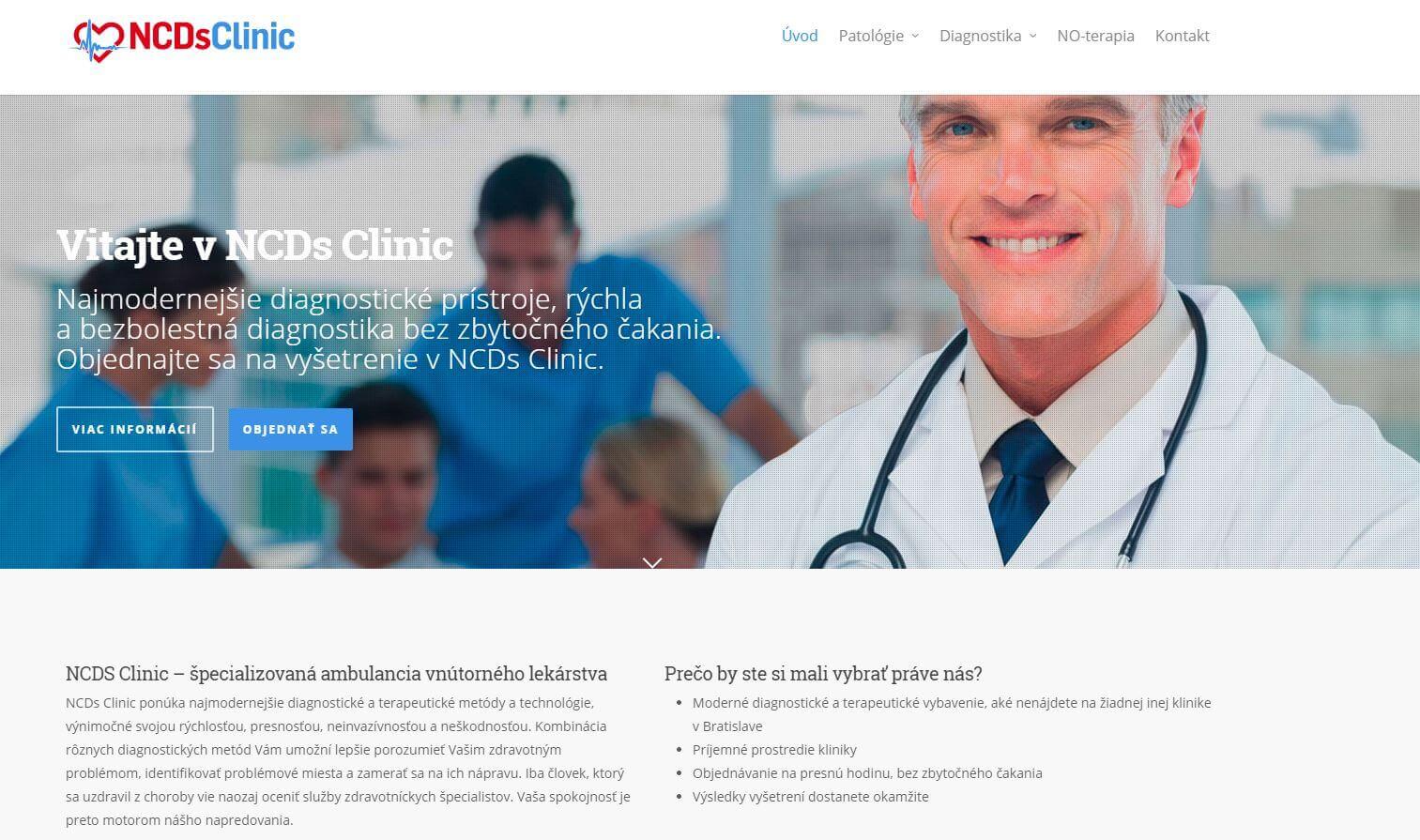Medical devices
search
news
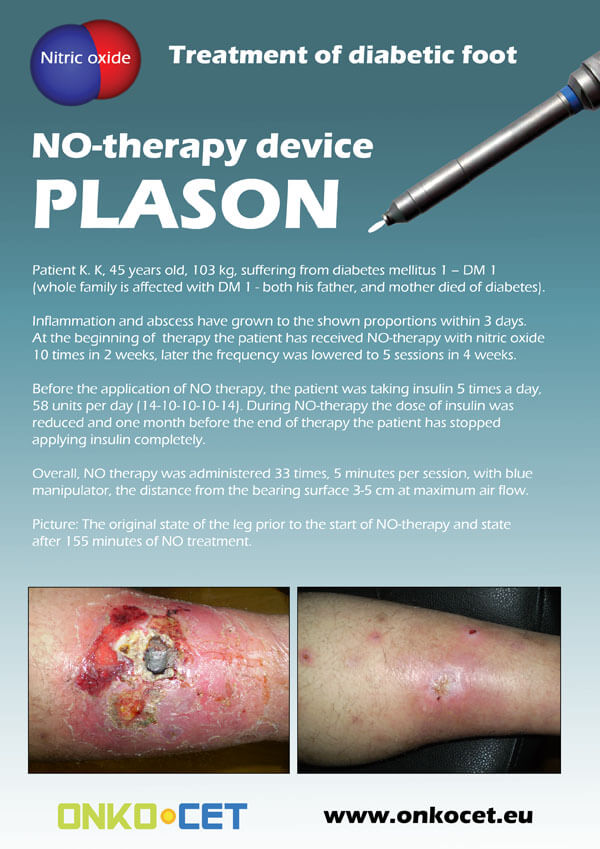
The PDF with the short report with pictures from the therapy of a diabetic foot can be viewed or downloaded here.
The pictures from the treatment of unhealing wounds an be found here:
http://www.onkocet.eu/en/produkty-detail/220/1/
The pictures from the treatment of unhealing wounds an be found here:
http://www.onkocet.eu/en/produkty-detail/293/1/
ONKOCET Ltd. has exhibited the devices from its portfolio on the MEDTEC UK exhibition in Birmingham, April 2011 through our partner Medical & Partners.
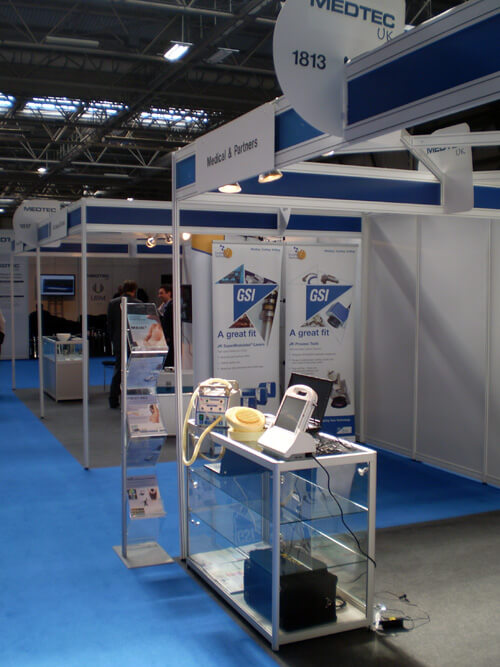
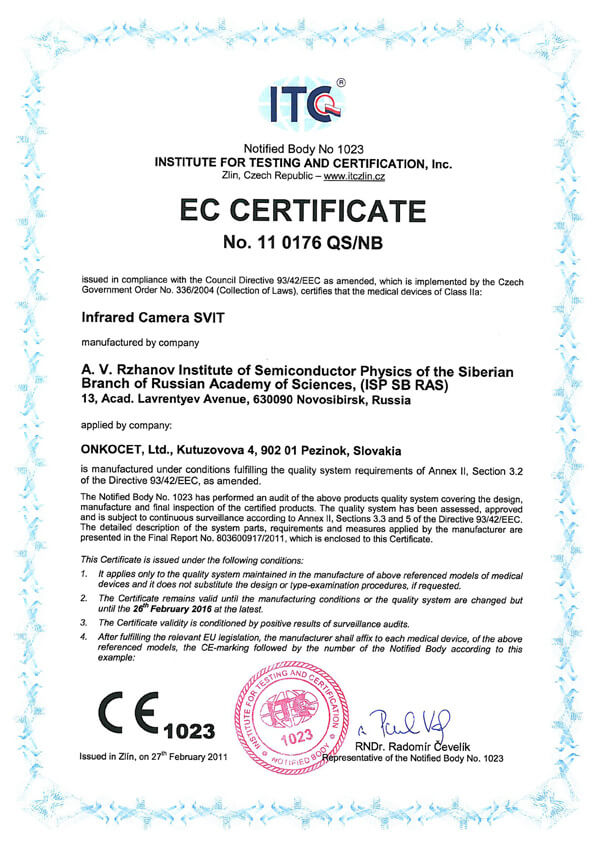 The ONKOCET company has successfully reached the certification of yet another medical device, Infrared Camera SVIT. The Certificate can be found here. The videos from the device operation can be found here.
The ONKOCET company has successfully reached the certification of yet another medical device, Infrared Camera SVIT. The Certificate can be found here. The videos from the device operation can be found here.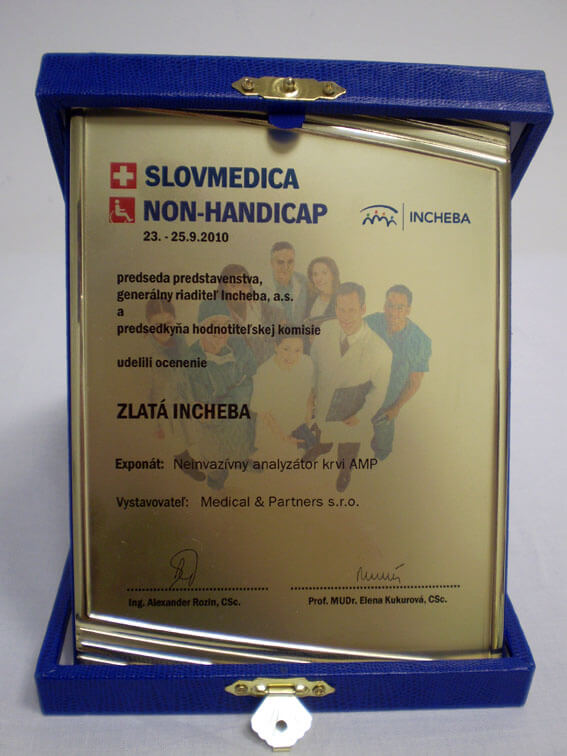 Our device, the non-invasive blood analyzer AMP has won the Golden Incheba prize at a medical exhibition SLOVMEDICA - NON-HANDICAP 2010. A big thank you goes to the organizers of the exhibition for acknowledging the quality of our device and to the exhibitor, the Medical & Partners company, for introduction of the AMP device to the medical public again.
Our device, the non-invasive blood analyzer AMP has won the Golden Incheba prize at a medical exhibition SLOVMEDICA - NON-HANDICAP 2010. A big thank you goes to the organizers of the exhibition for acknowledging the quality of our device and to the exhibitor, the Medical & Partners company, for introduction of the AMP device to the medical public again.We are pleased to inform our business partners, that our company has succesfully finished the certification process of Concor Soft Contact Lenses.
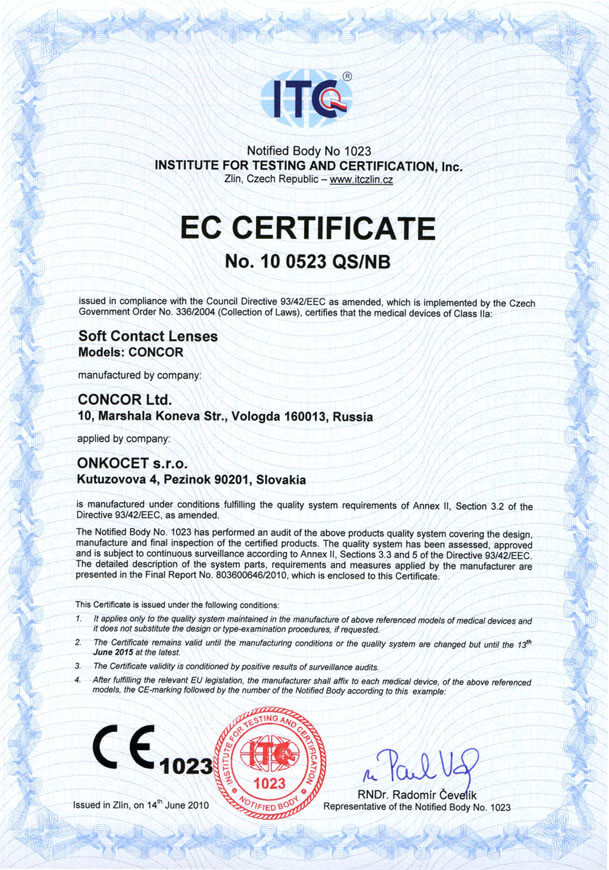 You can find the certificate here.
You can find the certificate here.More information on Concor Soft Contact Lenses go to section Medical preparations/Concor soft contact lenses, or follow this link.
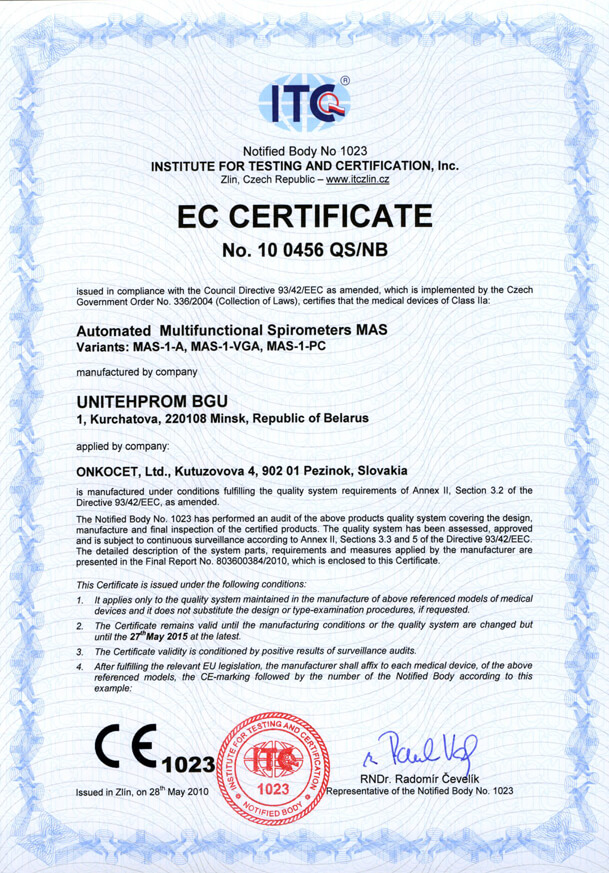 Our company has finished the certification process for another medical device, computerized spirometer MAS-1K with oximeter. You can find the device certificate here.
Our company has finished the certification process for another medical device, computerized spirometer MAS-1K with oximeter. You can find the device certificate here..jpg) Since May 2010 there is a new version of AMP device available.
Since May 2010 there is a new version of AMP device available.Follow this link if you want to see the pictures and specifications of the device.
http://www.onkocet.eu/en/produkty-detail/293/1/
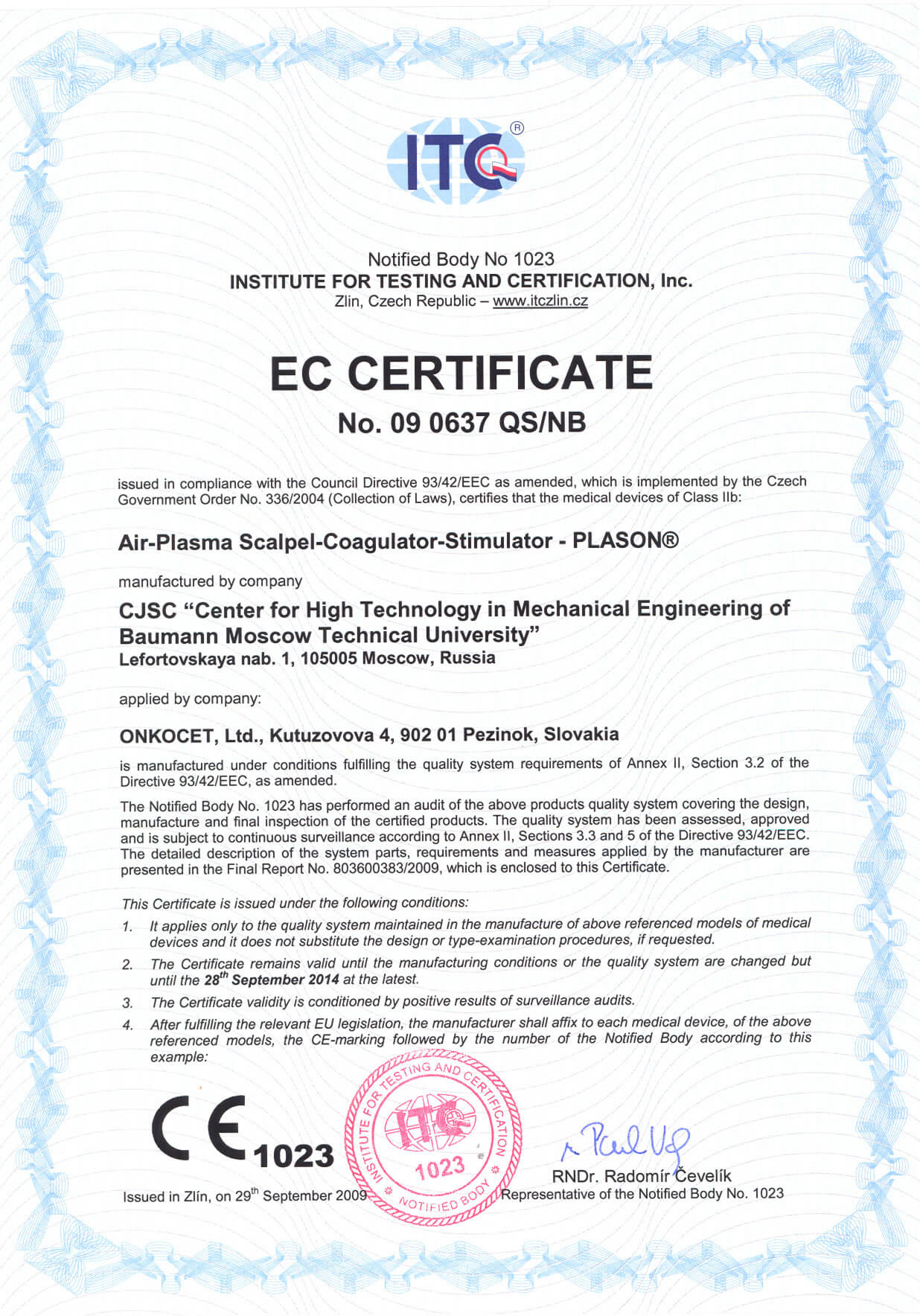 Dear partners,
Dear partners, In October 2009 we have received CE certificate for another device from our portfolio, NO therapeutical device PLASON. You can find more information about this revolutionary device, used for healing of unhealing wounds, diabetic foot, or for cosmetical purposes, at our webpage, section "Medical devices" -> PLASON-NO Therapy.
.gif)
Best regards
Team of ONKOCET Ltd. company
Physical process in skin tissues
The comparison of physical process taking place in skin tissues during different ways of cooling
Cryotherapy is often referred to the hypothermal treatment class baseol on the body cooling. Hypothermal is widely spread in medical treatment and know not only by specialist, but by a lot of patients too. Some technological similarity of cryogenic and hypothermal effects which is in the contact with low temperature heat source leads to the treatment acts are constantly compared and contrasted.
Hypothermia is easier in realization and is followed by large heat. That's why a lot of advertisers of hypothermal treatment prefer icy baths, saying that medical treatment effects of cryotherapy are the psychoemotional results of usage of extraordinary methods in body training. But at the same time long practice of "winter bathing" doesn't give examples of different diseases recovery. So hypothermal treatment doesn't ensure the achievement of physical results which are the basical advantage of cryotherapy and define its medical treatment.
For these differences revealing cryotherapy should be compared with traditional hypothermal baths with +120C temperature of water. Considering the opinion about the similarity of cryotherapy with winter bathing in the experiment process which are in the contact with icy water and skin (00C)
Physical model of skin tissue is used in numerical experiment where thickness of epithelium is 2 mm and adipose tissue is 10mm.
Gas temperature maybe defined as medium meaning:
Tkm= 140k or t = -1300C
heat diversion in compared procedures is ensured by natural convection of cooling medium in unlimited space. The whole duration of treatment is limited by value of 450 sec.
Simulating of the process of skin tissues by gas medium with the temperature of 1300C and water 0 - 120C, it indicated than the character of changing of temperature of skin surface in compared process are different. Figure #1.

Fig. 1. the changing of skin temperature in contact with different cooling mediums. (air: -1300C, water: 0 and +120C).
If there is a fast temperature lowering with cooling medium at the beginning of thermal contact in water treatment some minimum index.
Cryotherapy ensures the temperature lowering of skin surface contacting with cryogenic gas reached terminal index -20C. Near lower temperatures there possible to be the development of cooling processes on the skin which are not admitted in therapeutically applying of cryogenic temperatures, therefore further simulating of this variant was stopped.
Variants with liquid water cooling were stopped in 450 sec. After the beginning of the experiment. In fig. # 1 you can see that by this moment the temperature lowering of epithelium was almost finished. Besides rated duration of the body surface contact with cold water is enough big. Stay of a man in an icy water during winter bathing is limited by scoter time in tervals. In spite of big exposition of water contact with cooling medium, minimum temperature reached on the skin surface during water treatment is considerably higher than during usage of cryogenic gas. So, the skin surface temperature is lowered below +50C and in hypothermal bath is lowered from +120C to +150C. Cryotherapy differs from hypothermal treatment by the character of changing and size by skin surface is the physical factor ensuring medical efficiency of cryotherapy. Hypothermal treatment is not able to create temperature below +50C on skin surface that's why is doesn't give medical treatment as cryotherapy has.

Figure #2. Rated heat losses from skin surface.
During the experiment together with calculation of temperature, fields on skin surface the quantity of heat was calculated drained from body surface to cooling medium. These calculations were done in order to compare by the value of heat losses during cryotherapeutical and hypothermal treatment. The graph of the changing of specific heat draining from skin surface is in figure # 4. It is seen that in this case widespread idea about the physics of the process is not absolutely right.
Cryotherapy drains a large quantity of heat (near 450 kj/m2) from body surface, but the same heat losses are in hypothermal baths +120C. In icy water heat losses from body surface exceeded 600 kj/m2. Obtained result co-ordinates with practice it is known that the main factor of risk during «winter bathing» is high possibility of the body super cooling the discuses.
The second distinction of cryotherapy from traditional water treatment is rather small heat losses from skin surface watched with large temperature lowering of skin surface. From physical point of view this combination shows that during cryotherapy super cooling extends on small depth, that's why it turns well to super cooling body surface enough with small heat draining.

Figure #3. Rated heat flow through the interval boarder of edipose tissue.
Last idea is confirmed by the graph of heatflow changing, penetrating through the boarder of edipose and muscle tissues during different stages of treatment.
Edipose tissue plays the function of Passive thermalisolator, and we can say that the losses of organism nucleus are close to the value of heatflow, which goes through the boarder of muscle and edipose tissue. It is known from the literature, that nominal index of heatflow from body surface is 100 w/m2. The analysis of graphs mentioned shows, that during cryotherapy the losses of heat from internal organs up to the end of treatment don't exceed physiological standard therefore it keeps safety of external body. That's why cryotherapy is applied without limits connected without limits connected with the work of thermoregulation system. During hypothermia first of all for large increasing the duration of patient stay in the cooling medium the possibility of super cooling is very high in icy water heatdraining through edipose tissue exceeds physiological standard just after 1.5 min and by the end of treatment the body nucleus loses heat in 3 times more than standard is. It is interesting to note that in hypothermal bath the losses of heat from nucleus during first three minutes of contact are compared with heatdraining during cryotherapy and the danger of super cooling develops only at 4 minutes of treatment. We can suppose that any cooling treatments with work time up to 3.5 min are not able to create the conditions for dangerous super cooling.

Figure #4 the changing of the temperature of internal boarder of edipose tissue during various ways of cooling of skin tissue.
The consequence of excess losses of heat from body nucleus is definite lowering of temperature of internal boarder of edipose tissue. For all variants after 3 minutes rated index of temperature lowered on 10C from +370C to 360C. Taking into account the indexes of nucleus body heat losses, supercooling of internal boarder of edipose tissue on 10C it may be considered as safe for all categories of patients. By the end of hypothermal treatments the temperature of internal edipose tissue deviates from nominal value for 3-40C which is suitable only for healthy and trained people.
According to this article we can determine the conditions of hypothermal safety of patients. Treatments connected with cooling of skin surface are safe for patients up to the skin temperature higher than -20C (external condition of hypothermal safety) and the temperature of internal boarder of edipose tissue should be lowered below 360C (internal condition of hypothermal safety).
